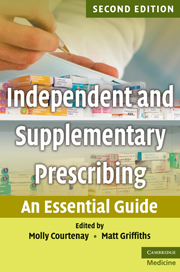Book contents
- Frontmatter
- Contents
- List of contributors
- Foreword to the second edition
- Preface to the second edition
- 1 Non-medical prescribing: an overview
- 2 Non-medical prescribing in a multidisciplinary team context
- 3 Consultation skills and decision making
- 4 Legal aspects of independent and supplementary prescribing
- 5 Ethical issues in independent and supplementary prescribing
- 6 Psychology and sociology of prescribing
- 7 Applied pharmacology
- 8 Monitoring skills
- 9 Promoting concordance in prescribing interactions
- 10 Evidence-based prescribing
- 11 Extended/supplementary prescribing: a public health perspective
- 12 Calculation skills
- 13 Prescribing in practice: how it works
- 14 Minimising the risk of prescribing error
- Index
- References
14 - Minimising the risk of prescribing error
Published online by Cambridge University Press: 10 January 2011
- Frontmatter
- Contents
- List of contributors
- Foreword to the second edition
- Preface to the second edition
- 1 Non-medical prescribing: an overview
- 2 Non-medical prescribing in a multidisciplinary team context
- 3 Consultation skills and decision making
- 4 Legal aspects of independent and supplementary prescribing
- 5 Ethical issues in independent and supplementary prescribing
- 6 Psychology and sociology of prescribing
- 7 Applied pharmacology
- 8 Monitoring skills
- 9 Promoting concordance in prescribing interactions
- 10 Evidence-based prescribing
- 11 Extended/supplementary prescribing: a public health perspective
- 12 Calculation skills
- 13 Prescribing in practice: how it works
- 14 Minimising the risk of prescribing error
- Index
- References
Summary
Preventable medication errors occur at all stages of the medicines use process. Prescribing is no exception to this.
Prescription is the first stage in the medicines use process and prescribing errors are possibly the most serious of all types of medication errors. Unless a prescribing error is detected by another person involved in medicine use, such as the pharmacist dispensing the medicine, the nurse administering the medicine or the patient for whom the medicine was prescribed, incorrect medicines will be taken or given, with the risk of harm. The extent to which a prescribing error causes harm will depend on the drug prescribed, the magnitude of the error if it is a dosing error, the number of doses of the incorrect prescription the patient receives, the clinical status of the patient exposed to the error and the setting in which the error occurs. The same error in two different patients can have very different outcomes.
Traditionally only doctors and dentists could prescribe medicines. Now pharmacists, nurses and allied health professionals are extending their patient care roles and prescribing either as supplementary prescribers in partnership with independent prescribers or independently in their own right. These new prescribers will be vulnerable to the same systemic causes of prescribing error as traditional prescribers.
This chapter describes prescribing errors, their causes and actions to be taken to minimise the risk of prescribing error.
- Type
- Chapter
- Information
- Independent and Supplementary PrescribingAn Essential Guide, pp. 187 - 198Publisher: Cambridge University PressPrint publication year: 2010



